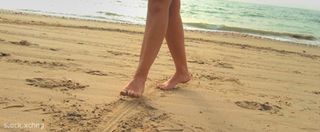Cursing The First Bipedal Apes

There are 26 bones in the human foot. These bones are connected to each other by ligaments, attached to muscles by tendons and interact at 33 joints. I've been thinking a lot about the human foot because I tripped and sprained my ankle last week and I can't walk. I can hobble, but not walk. And not walking makes me feel less human. Humans are the only mammals that rely on upright two-legged or bipedal locomotion. We stand tall, with our center of gravity deep within the bowl of the pelvis and our big heads nicely balanced on a curved spine. To move forward, we simply lift a leg by contracting a group of muscles called the iliopsoas that run from the spine and inside the pelvis to the top of the upper leg bone. From there, it's simply a matter of gravity. The body pitches forward and down we go, landing on a foot designed to take the impact; our big toe is aligned with the other toes rather than sticking out like a thumb which helps form a landing pad; the arch of the foot is a shock absorber that softens the impact of a whole body bearing down. They way we get around is in sharp contrast to our closest relatives, the African apes. Chimpanzee and gorillas lean forward, resting their weight on the tops of their knuckles as they move about the forest on their short legs. Their toes are as flexible as their fingers; they can grasp in the front and back, which works well in the trees. And so walking upright is a mark of our species; in fact, it was the first trait that distinguished us from the other apes. Ancient foot, leg and pelvic bones, and a set of footprints left in volcanic ash, show that our lower anatomy began to change at least 5 million years ago to accommodate standing up and walking. No one knows why bipedalism and all the necessary anatomical changes were favored. Perhaps we desperately wanted to see over tall grasses. Maybe it took less energy moving two rather than four limbs as we searched the forest and savannah for food. Or it might have been cooler to stand up and let the breeze waft through our hair on a hot savannah. But once those ape-like creatures began walking upright, it made them human. And so I hold those ancestors personally responsible for my bum ankle. It's their fault that I sit here today, immobile in a splint and ace bandage, not so patiently waiting for the days to pass until I can stand on two rather than one leg, walk and feel like a real person. Meredith F. Small is an anthropologist at Cornell University. She is also the author of "Our Babies, Ourselves; How Biology and Culture Shape the Way We Parent" (link) and "The Culture of Our Discontent; Beyond the Medical Model of Mental Illness" (link). Related Stories:
- Top 10 Missing Links
- Walk This Way: The Amazing Complexity of Getting Around
- Ten Things You Didn't Know About You
Sign up for the Live Science daily newsletter now
Get the world’s most fascinating discoveries delivered straight to your inbox.
